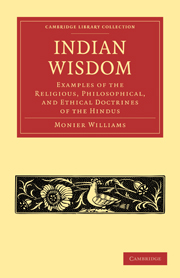Book contents
- Frontmatter
- PREFACE
- THE INDO-ROMANIC ALPHABET WITH THE EQUIVALENT SANSKṚIT LETTERS AND RULES FOR PRONUNCIATION
- Contents
- INTRODUCTION
- LECTURE I The Hymns of the Veda
- LECTURE II The Brāhmana Portion of the Veda
- LECTURE III The Systems of Philosophy
- LECTURE IV The Nyāya System of Philosophy
- LECTURE V The Sānkhya System of Philosophy
- LECTURE VI The Mimāṉsā System of Philosophy
- LECTURE VII Irregular Systems and Eclectic School
- LECTURE VIII Smṛiti. The Vedāngas
- LECTURE IX Smārta-sūtra. Gṛihya, ‘domestic rules’
- LECTURE X The Law-books. Mainu continued
- LECTURE XI Metrical Version of some of Manu's Moral and Religious Precepts
- LECTURE XII The Epic Poems
- LECTURE XIII The Mahā-bhārata
- LECTURE XIV The Epic Poems compared together and with Homer
- LECTURE XV The Artificial Poems
- INDEX
- ADDITIONS AND CORRECTIONS
- ORIENTAL WORKS
LECTURE XIII - The Mahā-bhārata
Published online by Cambridge University Press: 29 August 2010
- Frontmatter
- PREFACE
- THE INDO-ROMANIC ALPHABET WITH THE EQUIVALENT SANSKṚIT LETTERS AND RULES FOR PRONUNCIATION
- Contents
- INTRODUCTION
- LECTURE I The Hymns of the Veda
- LECTURE II The Brāhmana Portion of the Veda
- LECTURE III The Systems of Philosophy
- LECTURE IV The Nyāya System of Philosophy
- LECTURE V The Sānkhya System of Philosophy
- LECTURE VI The Mimāṉsā System of Philosophy
- LECTURE VII Irregular Systems and Eclectic School
- LECTURE VIII Smṛiti. The Vedāngas
- LECTURE IX Smārta-sūtra. Gṛihya, ‘domestic rules’
- LECTURE X The Law-books. Mainu continued
- LECTURE XI Metrical Version of some of Manu's Moral and Religious Precepts
- LECTURE XII The Epic Poems
- LECTURE XIII The Mahā-bhārata
- LECTURE XIV The Epic Poems compared together and with Homer
- LECTURE XV The Artificial Poems
- INDEX
- ADDITIONS AND CORRECTIONS
- ORIENTAL WORKS
Summary
I PASS on now to the Mahā-bhārata—probably by far the longest epic poem that the world has ever produced. Its main design is to describe the great contest between the descendants of king Bharata. He was the most renowned monarch of the Lunar dynasty, and is alleged to have reigned in the neighbourhood of Hastināpur or ancient Delhi, and to have extended his authority over a great part of India, so that India to this day is called by the natives Bhārata-varsha. The great Epic, however, is not so much a poem with a single subject as a vast cyclopædia or thesaurus of Hindū mythology, legendary history, ethics, and philosophy. The work, as we now possess it, cannot possibly be regarded as representing the original form of the poem. Its compilation appears to have proceeded gradually for centuries. At any rate, as we have already indicated (pp. 319, 320), it seems to have passed through several stages of construction and recongtruction, until finally arranged and reduced to orderly written shape by a Brāhman or Brāhmans, whose names have not been preserved. The relationship which the original Brāhman compiler bore to the scattered legends and lays of India, many of them orally transmitted until transferred to the Mahā-bhārata, was similar to that borne by Pisistratus to the Homeric poems. But the Hindūs invest this personage, whoever he was, with a nimbus of mystical sanctity, and assert that he was also the arranger of various other celebrated religious works, such as the Vedas and Purāṇas. He is called Vyāsa, but this is, of course, a mere epithet derived from the Sanskṛit verb vy-as, meaning ‘to dispose in regular sequence,’ and therefore would be equally applicable to any compiler.
- Type
- Chapter
- Information
- Indian WisdomExamples of the Religious, Philosophical, and Ethical Doctrines of the Hindus, pp. 371 - 414Publisher: Cambridge University PressPrint publication year: 2010First published in: 1875

